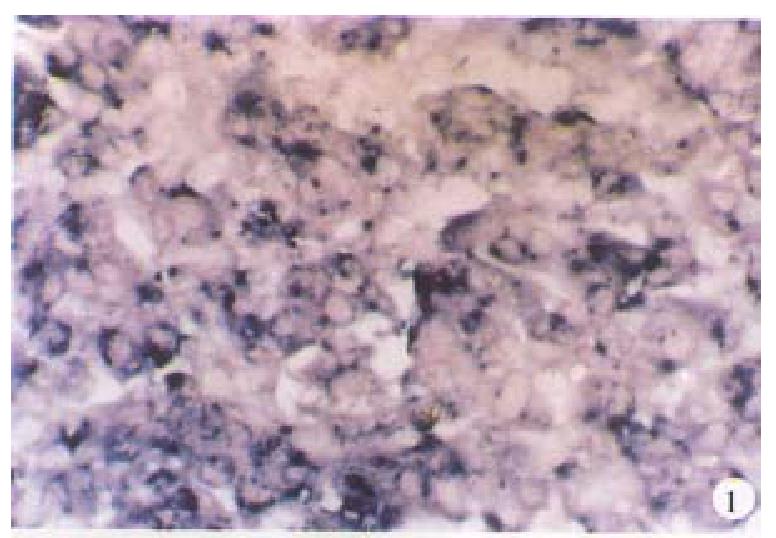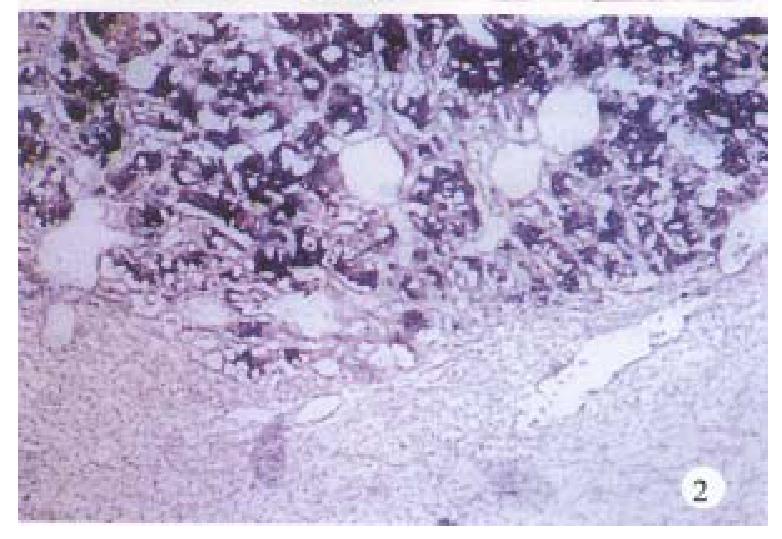Published online Oct 15, 1998. doi: 10.3748/wjg.v4.i5.412
Revised: August 15, 1998
Accepted: September 21, 1998
Published online: October 15, 1998
AIM: To detect the expression of CD44v6 mRNA and nm23-H1 mRNA in hepatocellular carcinoma (HCC) by in situ hybridization, and to evaluate the relationship between their expression and also relationship between their expressions and tumor invasion and metastasis.
METHODS: CD44v6 cDNA probe was synthesized with PCR technique and the nm23-H1 cRNA probe by in vitro transcription. The expression of CD44v6 mRNA and nm23-H1 mRNA was detected by in situ hybridization.
RESULTS: In group with high invasion and metastasis potential, the positive rates of CD44v6 mRNA and nm23-H1 mRNA were 80% (8/10) and 40% (4/10),in group with poor invasion and metastasis potential, they were 21.7% (5/23) and 91.3% (21/23). There was a positive correlation between the expression of CD44v6 mRNA and tumor invasion and metastasis potential in HCC (P < 0.01), and a reverse correlation between the expression of nm23-H1 mRNA and tumor invasion and metastasis potential (P < 0.01) and a reverse correlation in the expression between CD44v6 mRNA and nm23-H1 mRNA in HCC (P < 0.01).
CONCLUSION: Detection of CD44v6 mRNA and nm23-H1 mRNA may be useful for tumor invasion and metastasis in HCC.
- Citation: Xiao CZ, Dai YM, Yu HY, Wang JJ, Ni CR. Relationship between expression of CD44v6 and nm23-H1 and tumor invasion and metastasis in hepatocellular carcinoma. World J Gastroenterol 1998; 4(5): 412-414
- URL: https://www.wjgnet.com/1007-9327/full/v4/i5/412.htm
- DOI: https://dx.doi.org/10.3748/wjg.v4.i5.412
CD44 is a cell surface transmembrane glycoprotein. As a kind of adhesive molecule, it participates in cell-cell and cell-matrix adhesion and interactions. Many studies revealed a correlation between high-level expression of CD44, especially CD44v and tumor invasion, metastasis and prognosis. The exon 6v containing isoforms may be an independent diagnostic parameter[1,2]. Some other studies, however, had different results[3,4]. Some researches showed a reverse correlation between the expression of nm23-H1 mRNA and tumor metastasis[5,6]. In order to evaluate the relationship between the expression of CD44v6 mRNA and nm23-H1 mRNA and tumor invasive and metastatic potential in HCC and to evaluate the relationship in the expression between CD44v6 mRNA and nm23-H1 mRNA, we detected their expression in HCC by in situ hybridization.
Thirty-three cases of surgically resected HCC specimens were studied, including 24 males and 9 females, aged from 28-61 years (average 45.2 years). According to the clinicopathological data, the specimens were divided into two groups: high invasion and metastasis potential group (high-risk group) and poor invasion and metastasis potential group (low-risk group). The specimens meeting with the following standards were assigned to the high-risk group: (1) presence of metastasis in hepatic portal lymph nodes; (2) tumor embolus in the portal vein; and tumor satellite nodules near the main mass or tumor capsule deficiency or capsule infiltrated or even penetrated. Ten of 33 cases of HCC tended to belong to the high-risk group, 23 to the low-risk group.
CD44-cDNA-containing plasmid PGEX-2T was obtained from Dr. Ursula Gunthert (Basel Institute for Immunology, Switzerland). CD44v6 primers: 5’ TCCAGGCAACTCCTAGTAGT and 5’ CAGCTGTCCCTGTTGTCGAA. The conditions of PCR were 94 °C for 30 s, 60 °C for 30 s, 72 °C for 1 min, repeated for 30 cycles. The probes were labeled with Bio-11-dUTP (Boehringer Mannheim).
PGEM-4Z constructed with the nm23-H1 cDNA insert was linearized with Hind III and transcribed in vitro from the SP6 polymerase promoter to yield the antisense RNA probe and from the T7 polymerase promoter to yield the sense RNA probe (control) with Dig-RNA labeling Kit (Boehringer Mannheim).
Frozen sections were cut at 8 μm, washed in 0.1 mol/L PBS, glycine/ PBS and Triton X-100/ PBS, and were then treated with 0.1% proteinase K, and fixed in 4% paraformaldehyde, immersed in freshly prepared 0.25% acetic anhydride, and in 0.1 mol/L triethanolamine and washed with 2 × SSC. Each slide was covered with 20 µL-40 µL hybridization solution containing CD44v6 cDNA probe (denatured before hybridization) or nm23-H1 cRNA probe (digested with proteinase K after hybridization). Hybridization was performed at 50 °C-55 °Cfor 12-16 h in a moisture chamber, washed with 4 × SSC, 2 × SSC and 1 × SSC, incubated with avidin-AP or anti-Dig-Fab-AP, and stained with freshly prepared NBT-BCIP.
The sections were pretreated with RNase A (0.05 g/L) for 30 min at 37 °C. The procedures were the same as above but without probe in hybridizationsolution.
The significance of differences was tested by χ2 test.
Positive granules for hybridization signal were mainly distributed in cytoplasm of HCC cells (Figure 1). Eight of 10 cases in high-risk group and 5 of 23 cases in low-risk group were positive. And difference between the two groups was significant (P < 0.01). There was a positive correlation between the expressions of CD44v6 mRNA and tumor invasive and metastatic potential.
Positive granules for hybridization signal were mainly distributed in cytoplasm of HCC cells (Figure 2), 4 of 10 cases in high-risk group and 21 of 23 cases in low-risk group were positive, the difference being singificant (P < 0.01). There was a reverse correlation between the expressions of nm23-H1 mRNA and tumor invasive and metastatic potential.
In situ hybridization showed that nm23-H1 mRNA was present in 20 cases, in which CD44v6 mRNA expression was all negative, and nm23-H1 mRNA was negative in 8 cases and positive in 5 cases of 13 cases with CD44v6 positive expression. There was a reverse correlation between the expressions of CD44v6 mRNA and nm23-H1 mRNA (P < 0.01).
CD44 is a cell surface transmembrane glycoprotein. As a kind of adhesion molecule, it mainly participates in cell-cell and cell-matrix interactions. In human CD44 gene is located at chromosome 11p13. Many studies showed that high-level expression of CD44 especially CD44v was correlated with tumor invasion and metastasis, the exon 6v containing isoforms may be an independent diagnostic parameter[1,2]. Some studies have demonstrated that CD44 expression was positively correlated with the metastasis of hepatocellular carcinoma[7,8]. The following methods were mainly adopted: detection of the CD44 proteins by immunohistochemistry or detection of CD44 mRNA by RT-PCR. CD44 mRNA was detected by in situ hybridization only in colorectal carcinomas[9]. Because the formation of tumor invasion and metastasis was a multi-step process regulated by multi-gene and multi-factors, and the function of CD44 in tumor invasion and metastasis must be regulated by other genes. Some studies showed that the expression of nm23-H1 mRNA was closely related to tumor metastasis, and was regarded as the candidate gene of tumor metastasis inhibitory gene[5,6]. Due to the functional difference between CD44 gene and nm23 gene, it is significant to evaluate the relationship between their expressions, so as to understand and explain the mechanism of tumor metastasis. We synthesized CD44v6 cDNA probes by PCR, and detected the expression of CD44v6 mRNA by in situ hybridization in 33 cases of HCC. The results showed that CD44v6 mRNA expression was positively related to tumor invasive and metastatic potential. We detected the expression of nm23-H1 mRNA in these specimens, and found that there was a reverse correlation between the expression of nm23-H1 mRNA and CD44v6 mRNA. However, whether such correlation is of certain significance, which factor is a decisive one, and whether other exons of CD44 participate in tumor metastasis, still await farther studies.
As CD44 molecule is highly variable, the molecular structure of CD44 varies in different tissues or cells. But the probes used in current studies were produced with multi-exon continent. This kind of probes showed different hybridization abilities with different CD44 molecules in different tissues or cells. This might affect the accuracy of hybridization. If the different primers are designed to produce the cDNA probes formed from one of the exons in the probe synthesis by PCR, and if SS-cDNA probe is obtained by non-symmetry PCR, the sensitivity and stability of hybridization can be improved and non-radiation libeling can be completed at the same time. Thus, the complicated techniques and equipment in RNA probe preparation and in situ hybridization can be avoided. A plenty of probes can be obtained in a short time with PCR technique and can meet the needs of large numbers of detection.
In conclusion, the detection of CD44v6 mRNA and nm23-H1 mRNA may be useful for diagnosis and prediction of tumor invasion and metastasis in HCC.
Project supported by the National Natural Science Foundation of China, No.39370294
| 1. | Seiter S, Arch R, Reber S, Komitowski D, Hofmann M, Ponta H, Herrlich P, Matzku S, Zöller M. Prevention of tumor metastasis formation by anti-variant CD44. J Exp Med. 1993;177:443-455. [RCA] [PubMed] [DOI] [Full Text] [Full Text (PDF)] [Cited by in Crossref: 227] [Cited by in RCA: 250] [Article Influence: 7.8] [Reference Citation Analysis (0)] |
| 2. | Harn HJ, Ho LI, Yu CP, Wang MW, Lee HS, Lin JJ, Lee WH, Isola NR, Cooper DL. The variant mRNA isoform of human metastasis gene (CD44V) detected in the cell lines of human hepatocellular carcinoma. Biochem Mol Biol Int. 1994;32:233-238. [PubMed] |
| 3. | Fox SB, Fawcett J, Jackson DG, Collins I, Gatter KC, Harris AL, Gearing A, Simmons DL. Normal human tissues, in addition to some tumors, express multiple different CD44 isoforms. Cancer Res. 1994;54:4539-4546. [PubMed] |
| 4. | Terpe HJ, Christiansen H, Gonzalez M, Berthold F, Lampert F. Differentiation and prognosis of neuroblastoma in correlation to the expression of CD44s. Eur J Cancer. 1995;31A:549-552. [RCA] [PubMed] [DOI] [Full Text] [Cited by in Crossref: 18] [Cited by in RCA: 19] [Article Influence: 0.6] [Reference Citation Analysis (0)] |
| 5. | Iizuka N, Oka M, Noma T, Nakazawa A, Hirose K, Suzuki T. NM23-H1 and NM23-H2 messenger RNA abundance in human hepatocellular carcinoma. Cancer Res. 1995;55:652-657. [PubMed] |
| 6. | Chen X, Dai Y, Yang J. [Expression of metastasis suppressor gene nm23 in human hepatocellular carcinoma]. Zhonghua Binglixue Zazhi. 1996;25:76-78. [PubMed] |
| 7. | Mathew J, Hines JE, Obafunwa JO, Burr AW, Toole K, Burt AD. CD44 is expressed in hepatocellular carcinomas showing vascular invasion. J Pathol. 1996;179:74-79. [RCA] [PubMed] [DOI] [Full Text] [Cited by in RCA: 3] [Reference Citation Analysis (0)] |
| 8. | Washington K, Telen MJ, Gottfried MR. Expression of cell adhesion molecule CD44 in primary tumors of the liver: an immunohistochemical study. Liver. 1997;17:17-23. [PubMed] |
| 9. | Gorham H, Sugino T, Woodman AC, Tarin D. Cellular distribution of CD44 gene transcripts in colorectal carcinomas and in normal colonic mucosa. J Clin Pathol. 1996;49:482-488. [RCA] [PubMed] [DOI] [Full Text] [Cited by in Crossref: 24] [Cited by in RCA: 26] [Article Influence: 0.9] [Reference Citation Analysis (0)] |










